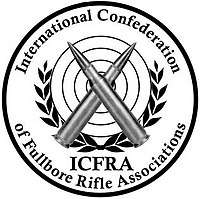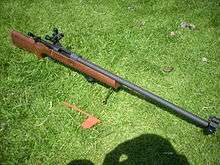International Confederation of Fullbore Rifle Associations
The International Confederation of Fullbore Rifle Associations (ICFRA) is the international association for the fullbore target rifle shooting sports of Palma and F-Class, which are long range competitions shot at distances between 300 and 900 meters or 300 to 1,000 yards depending on the range.[1] F-Class often shoot concurrently with the world's long-range Palma shooters and uses the same targets, except that the F-Class target has an extra half diameter inner ring. ICFRA seeks to standardize the competition rules for Palma and F-Class around the world.[2] In competitions, wind reading skills are important, and in order to hit their targets competitors must sense wind direction and speed, and adjust their sights accordingly by applying knowledge and experience about wind drift's effect on the bullet. The World Long-Range Rifle Team Championships is hosted every four years, where the winner is awarded the Palma trophy.
 | |
| Sport | Fullbore rifle |
|---|---|
| Jurisdiction | |
| Membership | 12 full members, 20 affiliated members, 2 observer members |
| Abbreviation | ICFRA |
| Founded | July 2003 |
| Official website | |
| icfra | |
History
Palma shooting
Palma competition dates from 1876, featuring long-range rifle shooting, out to 1,000 yards. The first Palma match was contested by teams from the U.S., Australia, Canada, Scotland and Ireland (with muzzleloading rifles at that time). The matches continued to the late 1920s, and the trophy was eventually lost in Washington DC around the outbreak of WW2. The match was revived in the modern era in 1966 in Canada, and continues between teams from around the world. The PALMA bolt action rifles are 7.62mm NATO caliber (Winchester .308) and fire Match Grade ammunition using a 155 grain bullet using micrometer aperture (iron) sights.[3] The last two International Long-range Target Rifle Matches were held in Australia in 2011 and the U.S. in 2015, were won by Great Britain.[4]
F-Class
F-Class was started in Canada by the late George "Farky" Farquharson after whom the class is named.[5] In the United States, J.J. Conway is considered the "grandfather of F-Class".[6]
Formation of ICFRA
Starting at the 1999 Palma and Individual Long Range World Championship in South Africa, representatives of 14 countries met and a formed a steering committee to form the foundation of an international organization to become the successor of the Palma Council.[7] ICFRA was formally founded in July 2003.
Equipment classes
Palma (Target Rifle)
Palma is a fullbore rifle discipline shot with iron sighted rifles at ranges from 300 to 1000 yards. In international competitions, the only two permitted calibers are either caliber .223 Remington or .308 Winchester with maximum bullet weights of 80 grains (approx. 5.2 grams) or 155 grains (10 grams) respectively. [8]
- International Target Rifle class (Palma): Shot prone supported with a sling, no bipods or rests are permitted. Only iron sights are permitted. Minimum trigger pull weight is 500 grams (approximately 1.1 lbs). The total weight of the rifle is unlimited. The rifle must be chambered for either the unmodified .308 Winchester/ 7.62×51mm NATO or .223 Rem/ 5.56×45mm NATO cartridge cases. Bullet weight for .308 Win must be less than 156 grains (typically 155 grain bullets are used), and less than 81 grains for .223 Rem (typically 80 grain bullets are used).
For Palma, slings are permitted as shooting aid, and adjustable slings with arm cuffs and buckle adjustments are commonly used.[9] Special shooting jackets are permitted, which can increase the stability of the shooter, reduce movement of the firearm due to pulse, helps with consistent recoil management and provide padding for the elbows against the ground. Because of the tension of the sling and the weight of the rifle, it is common to use special padded shooting gloves in the support hand for comfort.
The type of diopter rear sights used in Palma shooting are often dubbed "micrometer aperture sights".[10] This nomenclature can be regarded as somewhat unprecise, since a sight adjustment of 1 micrometer combined with a typical sight radius of 1 meter corresponds to an angular adjustment of: 1 μm⁄1 m = 0.001 mm⁄1 m = 0.001 mrad. In practice, Palma rifles typically angular click adjustment of either 1⁄4 moa (0.073 mrad) or 0.1 mrad. Finer sight adjustments such as 1⁄8 moa (0.036 mrad) or coarser adjustments such as 1⁄2 moa (0.145 mrad) are less commonly seen on iron sighted full bore target rifles
 A U.S. marksman at the 2014 Inter-service Rifle Competition at Quantico Marine Base, Virginia.
A U.S. marksman at the 2014 Inter-service Rifle Competition at Quantico Marine Base, Virginia. An L81 A2 Cadet Target Rifle.
An L81 A2 Cadet Target Rifle.
F-Class

F-Class is a rapidly growing variant of Fullbore Target Rifle which permits optical telescopic sights and shooting rests in the front and rear like for instance like a bipod and/or bags. Competitions are fired at distances from 300 to 1000 yards, and the center of the target has an extra scoring ring which is half the size of the one used in traditional Palma shooting. Based on equipment, competitors can choose to compete in one of the two classes Open or Standard:
- F-Open (Open Class): All rifle calibers up to 8.89 mm (0.35 in) may be used, along with a scope, and one can choose between using front rest and rear bag, or a bipod/ backpack. The weight limit including optics is 10 kg (22 lb).[11]
- F-TR ("Target", Standard Class): A restricted class permitting a scope, bipod/ backpack and rear bag (no front rest), but the rifle has to be of either caliber .223 Remington or .308 Winchester. In addition, the weight limit including optics is 8.25 kg (18.2 lb).[11]
The 'F' in the name of the discipline is named after the Canadian shooter George Farquharson.
 A BCM Europearms rifle intended for use with front rest and rear bag in the F-Class Open.
A BCM Europearms rifle intended for use with front rest and rear bag in the F-Class Open. Another BCM Europearms rifle intended F-Class Open, this one with a bipod instead of a front rest.
Another BCM Europearms rifle intended F-Class Open, this one with a bipod instead of a front rest.
Ammunition
The reason for limiting bullet weights in the fullbore disciplines of Palma and F-Class Standard is to level the playing field and make the competition about wind reading skills instead of about equipment.[12] Lighter bullets usually have a lower ballistic coefficient and are therefore more susceptible to wind drift. .308 Winchester/ 7.62×51mm NATO is limited to a maximum bullet weight of 155 grains (ca. 10 grams), which can be seen as a little bit on the light side for the .308 caliber in long range shooting. .223 Rem/ 5.56×45mm NATO is limited to a maximum bullet weight of 80 grains (ca 5.2 grams), which can be seen as a little on the heavy side for the caliber, thus increasing the long range potential of the otherwise "inferior" .223 caliber compared to the .308.
The F-Class Open has no limitations on bullet weight, as long as the caliber is .35 or less. Note that some ICFRA member associations may have additional national competition classes with other caliber and equipment restrictions.
Other equipment and accessories
All competitors are allowed to use a spotting scope while shooting. The most important use of the spotter scope is reading the wind by watching mirage downrange, which is easier with higher magnification. Scopes with powers between 30 and 50× and a lens diameter of 50 mm or larger are commonly used.[9] When shooting at paper targets, another common use of the spotting scope is to spot for the scoring disks which are placed onto the targets by range personnel to indicate the score. The use of scoring disks is not necessary when using electronic targets.
All competitors may use a shooting mat for padding and insulation against the ground.
Match format
There are primarily two courses of fire in most major F-Class tournaments. A Palma match consists of three stages, 800, 900 and 1000 yards, with 15 shots for record at each distance. At 800 yards, the shooter is allowed unlimited sighters. However, only two sighters are allowed at 900 yards and 1000 yards. That dictates a different strategy for the longer distances. A tournament may consist of two or three Palma matches. The other course of fire that we commonly shoot has stages at 600 yards and 1000 yards, with 15- or 20-shot strings at each distance. A tournament will be three to five strings at each yardage, usually with unlimited sighters for each string.[6]

 Close view of one a shooter with a monitor besides him for electronic scoring.
Close view of one a shooter with a monitor besides him for electronic scoring. Spectators and competitors relax between the shooting.
Spectators and competitors relax between the shooting.
Distances and targets
ICFRA competitions can be held in either a short range or long range format, with distances either in the imperial yards or the metric meters. F-Class shoots at the same targets as Palma, but during the scoring process an extra inner ring (which is half the diameter of the V-bull) counts only for F-Class. The scoring is based on points, with the object to place shots as close to the center or "Bull" as possible.[5] While short range is shot at a different target size for each of the six distances, long range is shot at the one and same type of target at different distances.
The imperial short range distances are:
- 300 yd (274.32 m)
- 500 yd (457.2 m)
- 600 yd (548.64 m).
The metric short range distances are:
- 300 m
- 500 m
- 600 m.
Long range is shot between 700 m to 1000 yds (914.4 m).
| (image missing) | |||||||
|---|---|---|---|---|---|---|---|
| Long Range Target 700 m-1000 yd | |||||||
| Aiming Mark | 1120 mm | ||||||
| Extra inner ring (F-Class only) |
128 mm | ||||||
| V-Bull | 255 mm | ||||||
| Bull | 510 mm' | ||||||
| Inner | 815 mm | ||||||
| Magpie | 1120 mm | ||||||
| Outer | 1830 mm | ||||||
World Champions
The World Long-Range Rifle Team Championships is hosted every four years, where the winner is awarded the Palma trophy. Below is an incomplete list of previous world champions:[13]
Palma team event
- Overall
Individual Palma
The following categories are awarded:
- Overall
- Women
- Veterans (over 60 years)
- Age 21-25 years
- Age under 21 years
- Overall
| Year | Venue | |||
|---|---|---|---|---|
| 1992 | Raton, New Mexico, United States | |||
| 1995 | Trentham, New Zealand | |||
| 1999 | Bloemfontein, South Africa | |||
| 2003 | National Shooting Centre, Bisley, Great Britain | |||
| 2007 | Connaught, Canada | |||
| 2011 | Brisbane, Australia | |||
| 2015 | 669-77X |
668-75X |
666-78X |
Camp Perry, Ohio, United States |
- Veteran
| Year | Venue | |||
|---|---|---|---|---|
| 2003 | National Shooting Centre, Bisley, Great Britain | |||
| 2007 | Connaught, Canada | |||
| 2011 | Brisbane, Australia | |||
| 2015 | Camp Perry, Ohio, United States | |||
| 2019 | Seddon Range, New Zealand | |||
| 2023 | South Africa | |||
- Under 25 year
| Year | Venue | |||
|---|---|---|---|---|
| 2003 | National Shooting Centre, Bisley, Great Britain | |||
| 2007 | Connaught, Canada | |||
| 2011 | Brisbane, Australia | |||
| 2015 | 590-55X |
Camp Perry, Ohio, United States | ||
- Under 21 years
| Year | Venue | |||
|---|---|---|---|---|
| 2003 | National Shooting Centre, Bisley, Great Britain | |||
| 2007 | Connaught, Canada | |||
| 2011 | No championship held | |||
| 2015 | 590-58X |
Camp Perry, Ohio, United States | ||
Individual F-Class
- Overall
| Year | Class | Venue | |||
|---|---|---|---|---|---|
| 2002 | Connaught, Canada | ||||
| 2005 | Bloemfontein, South Africa | ||||
| 2009 | Open | National Shooting Centre, Bisley, Great Britain | |||
| 2009 | F-TR | National Shooting Centre, Bisley, Great Britain | |||
| 2013 | Open | Raton, New Mexico, United States | |||
| 2013 | F-TR | Raton, New Mexico, United States | |||
| 2017 | Open | Connaught, Canada | |||
| 2017 | Open - U25 | Connaught, Canada | |||
| 2017 | F-TR | Connaught, Canada | |||
| 2017 | FTR - U25 | Connaught, Canada | |||
| 2021 | Open | Bloemfontein, South Africa | |||
| 2021 | F-TR | Bloemfontein, South Africa | |||
| 2025 | Open | National Shooting Centre, Bisley, Great Britain | |||
| 2025 | F-TR | National Shooting Centre, Bisley, Great Britain | |||
See also
- Elcho Shield, a special annual fullbore competition out to 1200 yd (1100 m) with no sighting shots
- List of shooting sports organizations
- International T-Class Confederation (ITCC)
- Fullbore target rifle, generic term for Palma and F-Class
- High power rifle and Civilian Marksmanship Program, U.S. variants
References
- "ICFRA - Shooting Rules". www.icfra.com.
- "ICFRA - History of ICFRA". www.icfra.com.
- "Palma USA". Retrieved 31 March 2017.
- http://competitions.nra.org/documents/pdf/compete/nat-trophy/tro-090.pdf
- "F-Class Shooting: Dominion of Canada Rifle Association (DCRA)". dcra.ca.
- "The F-Class Winning Formula within AccurateShooter.com". www.accurateshooter.com.
- "Breaking Down the World Long Range Palma Championship". www.ssusa.org.
- "Palma Shooting — What Calibers Are Permitted? « Daily Bulletin". bulletin.accurateshooter.com.
- "About the Shooting Disciplines". www.mrra.org.
- Review of Phoenix Precision micrometer rear sights by AccurateShooter.com
- "NRA High Power Rifle Rules, Revised January 2014, p. 67-70" (PDF). Archived from the original (PDF) on 2014-02-22. Retrieved 2017-08-27.
- "Rules and Tips for Palma Rifle Shooting in the USA". www.6mmbr.com.
- "ICFRA - Results and histories". www.icfra.com.
